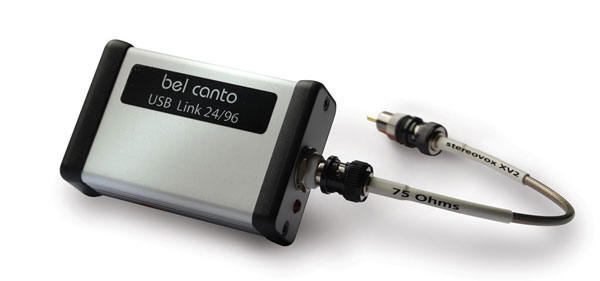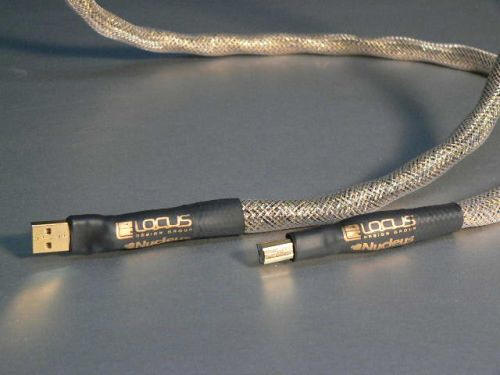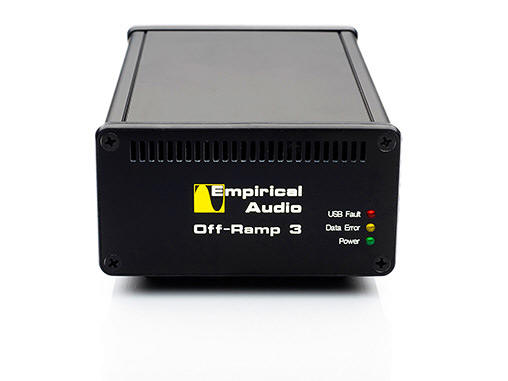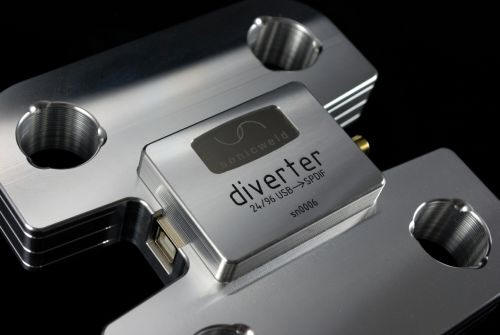|
You are reading the older HTML site Positive Feedback ISSUE 48march/april 2010
My Journey Down the USB
Path to Happiness
A year or so ago I was nowhere close to even being "on the fence" when it came to computer based music. It was not on my radar and, based on my experiences, I dismissed the source as simply not good enough for me to enjoy. However, I recall the moment when that all changed for me. I was sitting in front of Dave Clark's rig while he toggled between a Redbook and a digital file of the same track. The audio between the two sources was different, but for me almost negligible, and as I heard it the future was cast. Within two months, I sold my front-end in favor of CDP with a digital-in and purchased a Macbook computer. Then, I spent the next month ripping my CD collection. From that point on, as each week passed, the number of CDs spun in my Cary 306 Pro has decreased steadily to the point where, maybe, I listen to a new purchase through the transport, rip it, and then it is shelved. What came next, like all other audio pursuits, was the quest to see how these files can be made to sound as good as they possibly can in my system. USB cables, digital cables, power supplies, and USB converters all came into my world of possibilities. Over the course of the last year I have spent significant time with Kimber's copper and silver USBs, the Locus Designs Group Nucleus USB, the Bel Canto Link 24/96 Converter, the Off-Ramp (fully modded with Super Clock), and most recently the Sonicweld Diverter. There was a tentative process of investment while my digital conversion was taking place. Initially I used a stock USB I found in the family junk drawer connected to the Bel Canto using its BNC (w/RCA adapter) to the Cary. Soon after, I invested in the Kimber copper USB noting significant improvement in the reproduction of my music files… and in every way. Later, seeking to eke out even more performance—and thinking more is better—I replaced the Kimber copper with the Kimber "Silver". The copper improved the sound by a considerable amount but the Silver improved it still further, though by only a marginal amount at best. Nonetheless, it was an improvement so I kept the Silver. The Bel Canto Link 24/96 certainly converted the sound nicely and, with little computer audio experience to compare it to, it fell just short of a Redbook disc in the transport. I would describe it as I would suspect a lesser Cary CDP, the performance falls short of my reference Cary 306. That is, I would expect the "Cary" sound just not as resolute, full, or spatial as their top of the line CD/SACD player—the 306 Pro. I didn't hear the Bel Canto getting in the way of the Cary's signature; it just seemed to limit it ever-so-slightly. Consequently, if your particular player has a pleasing character that you enjoy, you can expect that same character through the Bel Canto Link, it just may be "less" of a good thing to which you have become accustomed to. At the same time, and a bit more speculative, I would think a moderately resolute system may not be able to discern the Bel Canto as any kind of a limiting factor. As with most of the less obvious audio bending components, if you don't have the system with sufficiently refined resolution to discern a power cord switch or the addition of an isolation device, any ‘issues' with the Link will not be heard.
The Bel Canto Link certainly did what it was supposed to do and it did it well. Comparing between a direct Redbook and a digital file off the MacBook and through the Bel Canto the CD won out every time. But, not by such a margin that made the music via the computer something I did not enjoy—not by a long stretch. The CD was better although the difference was more akin to a front end upgrade from within the same manufacturer's line, or the finding and swapping to a different or perhaps "better" set of cables. Regardless, by eventually listening to other systems, I became to believe that computer based audio could be as good, if not better, then a Redbook transport. The only question was then how to get there from here. To investigate, I decided to get my hands on the best possible USB I could and then ask myself if it sounded better and, if so, was such an improvement worth the cost. Thus, I replaced the Kimber with the Locus Design Nucleus USB ($1149), which at the time was the penultimate product within their USB line of cables (since surpassed by the Cynosure). Yes, there was a notable improvement on the order of refinement, depth, control, and image coherence. The increase in listening pleasure was at least as significant as the increase in listenability between the stock USB and the Kimber, which was a relatively profound leap. I will be the first to admit, I am not savvy in the ways of the 01 and 00's. That is not to say I am not computer savvy, because I am, it is just the minutia of the technology that is something I choose not to immerse myself into. I have enough going on and it seems there are mountains to conquer in this area if one chooses, even as a hobbyist. I do know there is a lot of debate regarding the effect one USB cable can have on digital information over that of another USB cable. While many conclude there is no difference, others conclude there can be no difference. However, I recall similar debates (some not so recent) in which the audible differences in interconnects and speaker wire were put into question on purely technical grounds. I can hear a difference between both aforementioned wires and I can appreciate that those differences are to me, a betterment of my system. In this case, the Locus Designs Nucleus moved my computer audio source much closer to that of my Redbook reference.
The Nucleus USB cleaned up the sound. It refined the digital edges and reinforced the bass output. Vocals were better defined and clearer. Again, as with the Bel Canto Link, the overall signature was that of my Cary 306 Pro. The Locus Design pushed the performance barrier of my computer based music that much closer to the performance of Redbook almost making the two ‘formats' indistinguishable, but not quite. Where it fell short was, again, the standard set in my system by Redbook playback. All the music was there, it sounded excellent but in a direct comparison to the CD it was not quite its equal. The Quest Continued Next, I got a hold of the Empirical Audio Off-Ramp with the Ultra Clock ($1499) along with Paul Hynes power supply ($500). Here is where the things became interesting …it now sounded as though the performance of my computer based audio system was no longer "defined" by the character of the DAC within the CDP. The Off-Ramp was more akin to moving speakers up the line from my Verity Audio Parsifal Ovations, i.e. the "Verity" sound was there, but it was moved toward a more detailed presentation. Not quite like moving from a soft down tweeter to a ribbon, but perhaps somewhere in between. Most interestingly, is that the Cary, or its inherent limitations, no longer seemed to be the dominant factor in the music being produced, at least not as dominant as it has been in the earlier iterations of my digital chain. It sounded as if the Empirical usurped control of the signal, converted it accordingly and fed the Cary with new information, which resulted in a remarkably different signature. The Empirical/Hynes combo pushed the digital signal to its full performance abilities. Highs were much more detailed and the outer edges of the entire frequency spectrum were acutely carved into the soundstage. With a pair of speakers like mine - pleasingly on the warmer side of neutral - a product like the Off-Ramp balanced out their style by infusing the music with a more analytical approach. So in this case it worked, but I would be a bit concerned about mating the Off-Ramp with already detail oriented speakers (or DAC for that matter) as the results could be too much of the same thing; a call you have to make based on your own preferences.
Nonetheless, the Off-Ramp proved to me that the "simple" act of USB conversion can have transforming effects on the sound of a system. Even more surprisingly, some aspect of the reproduction came to me as improved over the Redbook original. One track in particular, Ani Defranco's "Pulse" off Little Plastic Castles has a deep acoustic guitar bass thread throughout, the type of bass note that either benefits or is ruined by subtle movements in the speaker's position, power cord choices, and room treatments. Without hesitation, I can report that the bass was much better defined and extended, and more tunefully lower than my speakers had reached prior. It doesn't make logical sense to me, but that is what I can report. Overall, I think the distinction between the Empirical gear (with the Nucleus USB) and a Redbook disc was too close to call and became recording dependant. I can say that without the option to switch between sources only highlights the differences. If I started out with a DAC, the Empirical Off-Ramp, and the Locus Designs USB, I would have no reason to question the sound and would instead accept is as a solid high-end reference point. When I had the opportunity to get a review sample of the Sonicweld Diverter ($1299), I saw an opportunity to expand this journey even further so I took it. "Cool factor" of the Diverter is very high: CNC machined aluminum to a decidedly contemporary design; it is just nice to have it seen on the rack. As a reference point, the Off-Ramp and the Diverter are serious state of the art converters whose performances are on par, if not exceeding, that of Redbook discs. Where the Empirical gear pushed the digital realm to the best in digital, the Diverter redirected this digital realm towards that of a more organic sound. As much as the presentation was improved using the Empirical Off-Ramp, it was also improved with the Sonicweld. In absolute terms, the improvement to the digital file through either product was significant and "equal", but just differently so.
The Sonicweld Diverter offered a supple and easy presentation. I hesitate to call it "analog" because I have not been into analog since the 1980's introduction of the CD. However, I have been striving for an inviting and organic musical experience with my system ever since my first CD player. With that said, the Diverter takes my system, and thereby me, further towards that goal. With the Diverter I was easily carried out of my listening room and into the venue, or for that matter, wherever the music took me! My speakers disappeared more than they have in the past and the staging was much more enveloping. Just as the Empirical Off-Ramp was able to obtain performance with my music files beyond that of the typical Redbook CD, so too did the Diverter. I was able to hear further into the qualities of an organic presentation than I had before. Tones hinted of soothing complexities. The edginess most commonly associated with computer files, and digital music in general, was diminished significantly, though still present to some degree Vocals through the Diverter were realistic and full bodied, limited only by the associated gear of my system—which is true for all the items referenced in this article. These are not products to revolutionize your "system", but are intended to obtain the best possible sound from a digital file. All my reference standards, Stacy Kent, Dianne Reeves, and Ani DiFranco sounded as good as, and often better, than the disc they were ripped from. Logically, I am not sure how this can technically happen, but I can attest the Diverter connected me with the music more effectively then the disc. Everything listed in this article is good stuff. Whether or not you should seek to obtain any one of them depends on your budget and desire to seek the best from computer files. I can see that the future is with digital files, it has to be. The convenience and portability of the media alone would be the death of the disc. Add high quality reproduction and there is no end in sight—personally I can't wait. Regardless, the Locus Designs Nucleus USB and Sonicweld Diverter are going to keep me happy for some time to come. Bel Canto http://www.belcantodesign.com Empirical Audio http://www.empiricalaudio.com Paul Hynes http://www.paulhynesdesign.com Cryo Parts (Diverter and Nucleus USB Cables) http://www.cryo-parts.com
|





